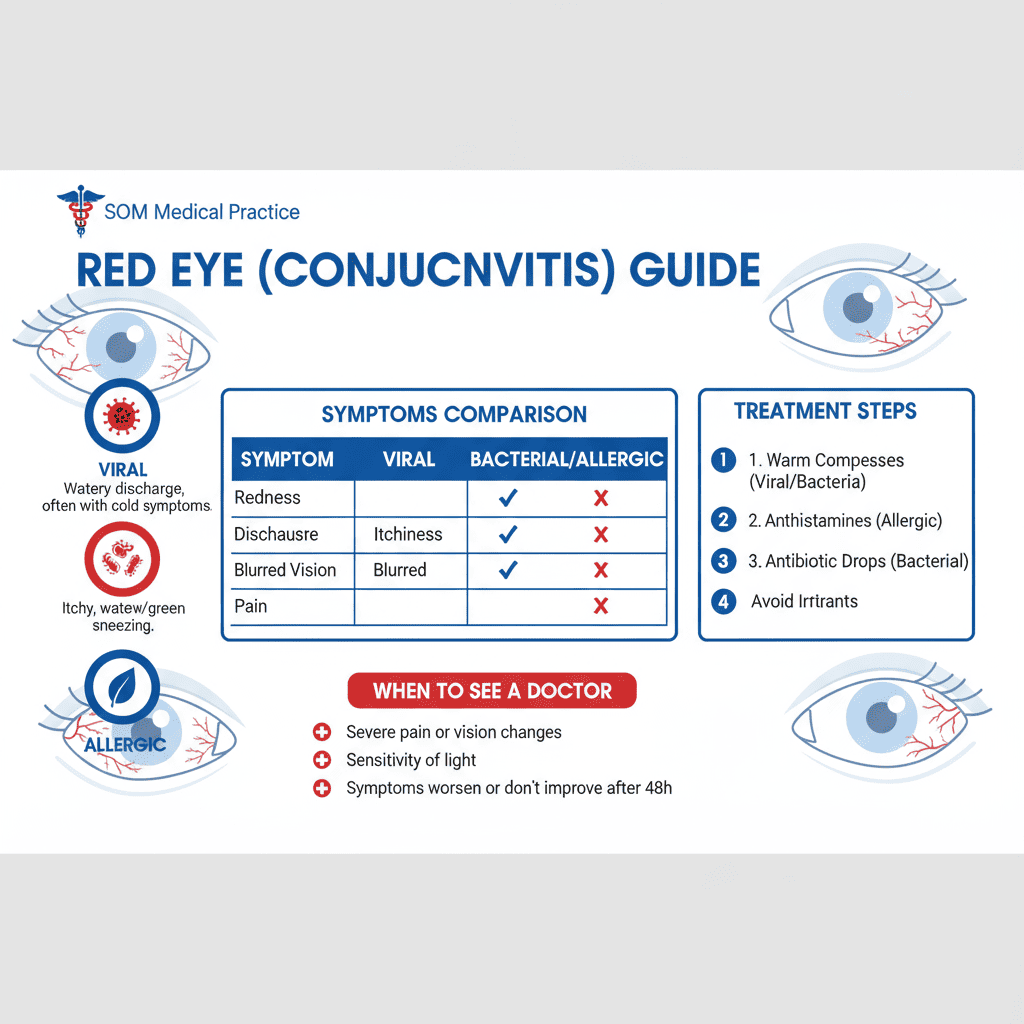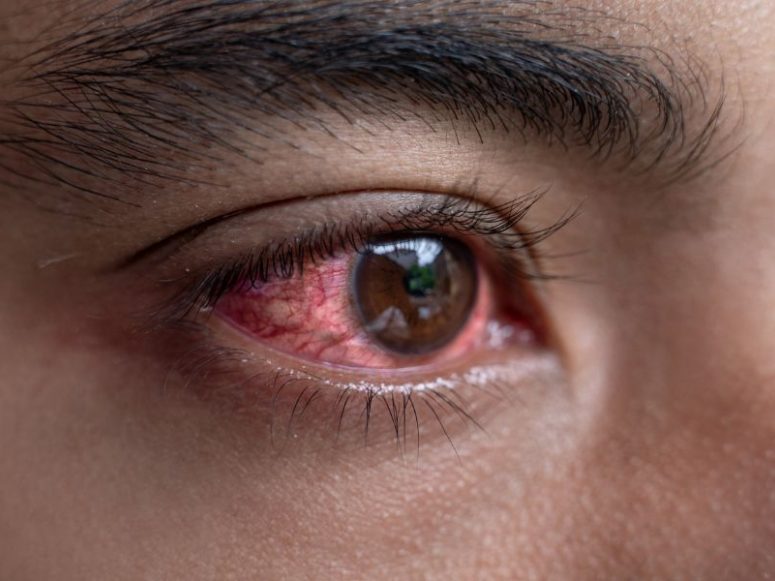Key Takeaways
- Red eye, or conjunctivitis, is an inflammation of the eye's outer membrane and can be caused by viruses, bacteria, or allergies. The cause determines whether it is contagious.
- Key symptoms help identify the type: viral often has watery discharge, bacterial has thick, colored discharge, and allergic is marked by intense itching.
- While many cases can be managed at home with cool compresses and good hygiene, you should see a doctor for severe pain, blurred vision, or symptoms that don’t improve.
Waking up with red, itchy, and irritated eyes is a common and uncomfortable experience. Often called "pink eye," the medical term for this condition is conjunctivitis. While it is usually not serious, it can be highly contagious and disruptive to your daily life. As a leading primary and urgent care provider in Western New York, SOM Medical Practice wants to provide you with a clear, complete guide to understanding red eye infections.
This article will walk you through the different types of conjunctivitis, how to identify them, what you can do for relief at home, and when it’s time to see a doctor.
1. What is Red Eye (Conjunctivitis)?
Conjunctivitis is the inflammation of the conjunctiva, which is the thin, transparent membrane that lines the inside of your eyelids and covers the white part of your eye. When the small blood vessels in this membrane become swollen and irritated, they become more visible, giving the eye a reddish or pink appearance. According to the Mayo Clinic, while it can be irritating, it rarely affects your vision [1].
2. The Three Main Types of Conjunctivitis
Understanding the cause of your red eye is key to getting the right treatment. There are three primary types of conjunctivitis:

| Type | Cause | Contagious? | Key Symptoms |
| Viral | Viruses, like adenovirus (similar to the common cold) | Yes, highly | Watery discharge, burning sensation, sensitivity to light. Often starts in one eye and spreads to the other. |
| Bacterial | Bacteria, such as Staphylococcus or Streptococcus | Yes | Thick, pus-like discharge (yellow or green), crusty eyelids, especially upon waking. |
| Allergic | Allergens like pollen, dust mites, or pet dander | No | Intense itching, redness, and tearing in both eyes, often accompanied by sneezing and a runny nose. |
Other less common causes include chemical irritants (like chlorine in a pool) or a foreign object in the eye [2].
3. How to Manage Red Eye Symptoms at Home
For mild cases of viral or allergic conjunctivitis, you can often find relief with simple home remedies. Bacterial conjunctivitis may require antibiotics, but these steps can help with comfort.
- Apply a Cool Compress: Soaking a clean, lint-free cloth in cool water and placing it over your closed eyes for a few minutes can help reduce inflammation and soothe itching.
- Use Artificial Tears: Over-the-counter lubricating eye drops can help relieve dryness and wash away irritants or allergens.
- Practice Good Hygiene: This is crucial, especially for contagious types. Wash your hands frequently, use a clean towel and pillowcase daily, and avoid sharing anything that touches your eyes, like towels or makeup.
- Avoid Touching Your Eyes: Rubbing your eyes can make the irritation worse and, if the infection is contagious, can easily spread it to your other eye or to other people.
- Stop Wearing Contact Lenses: If you wear contacts, switch to glasses until your eyes have fully healed. Wearing contacts can further irritate the eye and may trap bacteria or viruses.
4. When Should You See a Doctor?
While many cases of red eye resolve on their own, some symptoms warrant a visit to a healthcare professional to rule out a more serious condition and get proper treatment. According to the Cleveland Clinic, you should seek medical care if you experience any of the following [2]:
- Severe Eye Pain: Mild discomfort is common, but intense pain is not.
- Blurred Vision or Sensitivity to Light: If your vision is affected or you find it difficult to be in bright light, it could be a sign of a more serious problem.
- A Large Amount of Discharge: A significant amount of pus or mucus, especially if it is green or yellow, often indicates a bacterial infection that may require antibiotic eye drops.
- A Feeling that Something is Stuck in Your Eye: This could indicate a foreign body or a scratch on your cornea.
- Symptoms That Don't Improve: If your symptoms don't start to get better after a few days of home care, or if they get worse, it's time to see a doctor.
At SOM Medical Practice, our providers can perform an eye exam to diagnose the cause of your red eye and prescribe the appropriate treatment, whether it's antibiotic drops for a bacterial infection, antiviral medication for certain viruses, or allergy medication.
5. Preventing the Spread of Red Eye
If you or a family member has contagious conjunctivitis, taking a few simple precautions can help prevent it from spreading.
"Keep in mind that pink eye is no more contagious than the common cold. It's okay to return to work, school or child care if you're able to practice good hygiene and avoid close contact." - Mayo Clinic [1]
- Wash Hands Thoroughly: Use soap and water for at least 20 seconds, especially after touching your eyes.
- Don't Share Personal Items: Avoid sharing towels, pillows, eye drops, or makeup.
- Clean Surfaces: Regularly wipe down frequently touched surfaces like doorknobs, phones, and countertops.
Conclusion
Red eye, or conjunctivitis, is a common and usually mild condition, but it's important to know how to handle it. By identifying the type of conjunctivitis, you can take the right steps to find relief and prevent its spread. While home remedies are often effective, never hesitate to seek medical advice if you have severe symptoms or if your condition isn't improving.
For expert diagnosis and treatment of red eye and other urgent medical needs, visit SOM Medical Practice. Our dedicated team is here to provide the compassionate care you need to feel better, faster.
References
[1] Mayo Clinic. (2025). Pink eye (conjunctivitis). https://www.mayoclinic.org/diseases-conditions/pink-eye/symptoms-causes/syc-20376355
[2] Cleveland Clinic. (n.d.). Pink Eye (Conjunctivitis): Symptoms, Treatment & Causes. https://my.clevelandclinic.org/health/diseases/pink-eye-conjunctivitis








